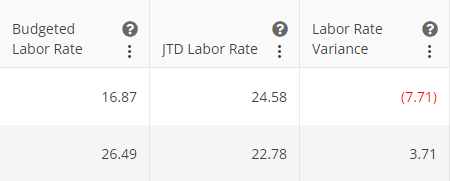For construction industry professionals, the tracking of Labor Rate Variance (LRV) is a crucial element in project management and financial forecasting
This metric measures the variance between the actual rate paid for labor and the standard or expected rate, thus highlighting the difference between projected labor costs and actual expenses.

Understanding Labor Rate Variance
Labor Rate Variance is calculated using the formula:
Labor Rate Variance= Approved Estimate Labor Rate – Job to Date Labor Rate

For instance, if a project estimated labor at $30 per hour but the actual cost was $35 per hour, the LRV would be: 30 – 35 = (5)
This negative variance indicates that labor costs were higher than anticipated, impacting project profitability.
Real-Life Examples and Impact
Consider two examples to understand the real-world impact of Labor Rate Variance.
Project A: The budget allowed for $40 per hour for skilled labor, but due to a sudden market demand for skilled workers, the actual wage rose to $45 per hour. Over 10,000 hours, the LRV is 10,000 \times ($45 – $40) = $50,000. This overrun could significantly impact profit margins if not managed properly.
Project B: A planned initiative to train workers led to increased efficiency, reducing the actual wage to $38 per hour. With 8,000 hours logged, the positive LRV is: 8,000 \times ($38 – $40) = -$16,000. This positive variance reflects a cost-saving, contributing directly to the bottom line. This positive variance reflects a cost-saving, directly contributing to the bottom line.
Strategies for Managing Labor Rate Variance
To effectively manage Labor Rate Variance, construction professionals can adopt the following strategies:
- Effective Planning: Careful analysis of labor trends and wage rates during the budgeting phase can reduce surprises.
- Training Programs: Investing in worker training can increase efficiency and offset higher wages through improved productivity.
- Flexible Workforce: Maintaining a balance between permanent and contract workers allows for adjustments according to project demands and labor market conditions.
- Negotiation and Contracts: Locking in labor rates through contracts can shield against unexpected wage inflation.
- Monitoring: Continuous monitoring of labor rates against benchmarks allows for early detection of variances and timely corrective actions [citation:6].
Conclusion
Tracking Labor Rate Variance (LRV) provides valuable insights into the direct impact of labor cost management on profitability in the construction industry.
Software solutions like Anterra’s can aid in accurate tracking and reporting of these variances, delivering actionable data for decision-making. This vigilance ensures competitive pricing, safeguards profit margins, and supports strategic planning.
Learn more about Job Forecasting on our website, or request a demo, below.
